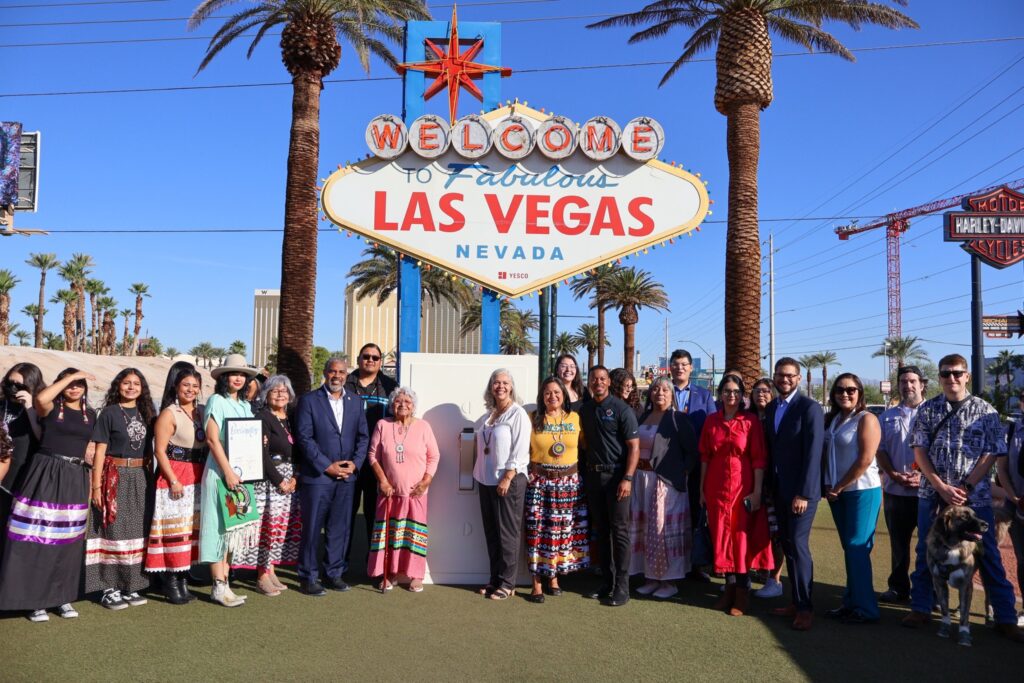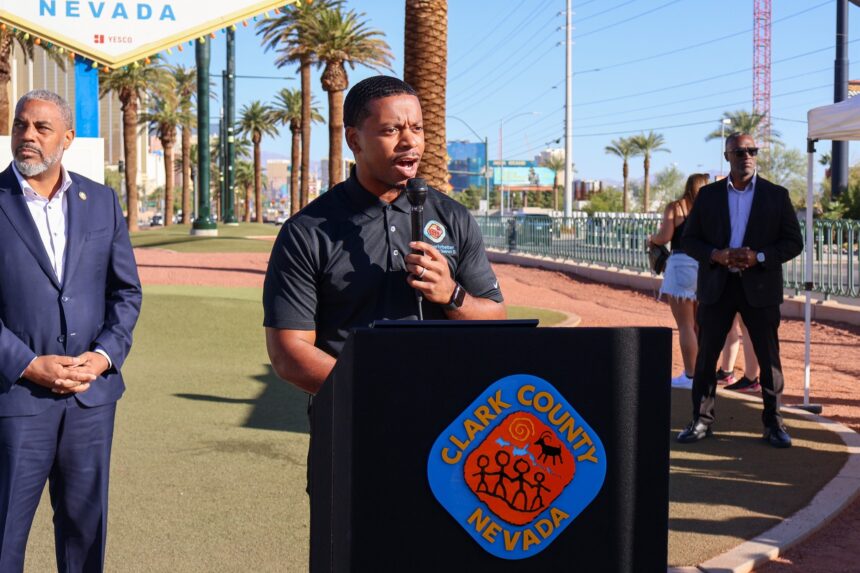LAS VEGAS (Oct. 13, 2025) — The iconic “Welcome to Fabulous Las Vegas” sign glowed in brilliant shades of yellow, orange, and turquoise on Monday evening as Clark County Commissioner William McCurdy II joined tribal leaders, local officials, and community members to celebrate Indigenous Peoples’ Day in Las Vegas.
The illumination ceremony at the southern gateway to the Strip served as a powerful tribute to Nevada’s 21 federally recognized tribes, representing 28 bands, councils, and communities that continue to shape the state’s culture, economy, and identity.
Commissioner McCurdy said the symbolic colors chosen for the sign represented “unity, healing, and resilience.” The event marked Clark County’s ongoing commitment to honoring the heritage of the first peoples who have called Southern Nevada home for thousands of years.
“Indigenous Peoples’ Day is more than just a date on the calendar,” McCurdy said during the ceremony. “It’s a reminder of the enduring presence and strength of Native communities across Nevada. The illumination of this historic Las Vegas landmark is our way of saying thank you — for the culture, the wisdom, and the spirit the tribes continue to share with us.”
Honoring the Original Stewards of the Land

Clark County sits on the traditional homelands of the Southern Paiute and Mojave peoples. Today, their descendants — including the Moapa Band of Paiutes Tribe, the Las Vegas Paiute Tribe, and the Fort Mojave Indian Tribe — maintain thriving communities throughout Southern Nevada.
The Moapa Band of Paiutes, located about 50 miles northeast of Las Vegas, are known for their renewable energy leadership and environmental stewardship. The Las Vegas Paiute Tribe, whose Snow Mountain Reservation borders the northern valley, operates successful enterprises including the Paiute Golf Resort and the downtown Las Vegas Paiute Smoke Shop. Meanwhile, the Fort Mojave Indian Tribe straddles the Nevada-Arizona-California border, preserving its distinct language, traditions, and ancestral lands along the Colorado River.
Together, these tribes reflect a living heritage that predates the founding of the state itself — a heritage that continues to enrich Nevada’s story.
A Symbol of Unity and Recognition
The annual Indigenous Peoples’ Day Las Vegas illumination was established as part of Clark County’s broader effort to promote cultural inclusivity and historical awareness. Since 2019, local leaders have joined Indigenous representatives to hold educational and ceremonial events each October, aligning with the nationwide observance that honors the resilience, achievements, and contributions of Native American communities.
McCurdy emphasized that the event was not just ceremonial but educational.
“When residents and visitors drive past the Welcome Sign tonight, they’re witnessing history and culture illuminated,” he said. “We want every Nevadan to recognize the tribes whose stories, traditions, and leadership continue to inspire us.”
The Commissioner also highlighted collaborative initiatives between Clark County and local tribes, including educational outreach, historical preservation projects, and community partnerships focused on youth empowerment and environmental sustainability.
Nevada’s Indigenous Legacy
Nevada’s Indigenous communities have been integral to the region’s growth and identity. From the mountains of Washoe Country to the canyons of Clark County, tribal nations such as the Shoshone, Washoe, and Paiute peoples have preserved deep spiritual and environmental ties to the land.
The modern celebration of Indigenous Peoples’ Day replaces the outdated recognition of Columbus Day in many jurisdictions, serving as a platform to uplift Indigenous voices and histories. In recent years, the State of Nevada and the City of Las Vegas have increasingly embraced Indigenous representation in public policy and community planning — a reflection of growing public awareness and support.
The illumination of the Las Vegas Welcome Sign, seen nightly by thousands of residents and tourists, provides an enduring visual tribute to that recognition. The colors — yellow for resilience, orange for connection to the earth, and turquoise for healing — echo the sacred tones found in Native art and symbolism throughout the Southwest.
Community and Cultural Reflection
Tribal leaders attending the ceremony expressed gratitude for Clark County’s commitment to recognition and visibility.
“Our people have always been here — long before the lights of the Strip,” said a representative of the Las Vegas Paiute Tribe. “Seeing the Welcome Sign shine in our colors reminds us that our stories are part of this city’s heartbeat.”
Dozens of residents gathered at sunset to watch the illumination, with many describing the event as both emotional and inspiring. Local educators and students also attended, using the occasion as a teaching moment about the importance of cultural respect and understanding.
A Continuing Tradition
Clark County’s annual participation in Indigenous Peoples’ Day represents an ongoing pledge to preserve and promote the voices of Native communities. Through partnerships with tribal governments, cultural centers, and nonprofit organizations, the County continues to develop programs that advance education, economic opportunity, and cultural preservation.
As the sun set over the desert horizon, the glowing hues of the Las Vegas Welcome Sign stood as a powerful reminder that the city’s brilliance extends far beyond its neon lights — to the people and traditions that have illuminated this land for centuries.


Leave a Reply